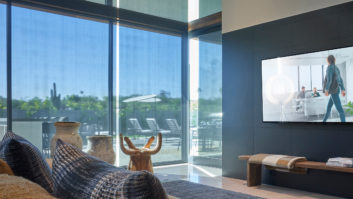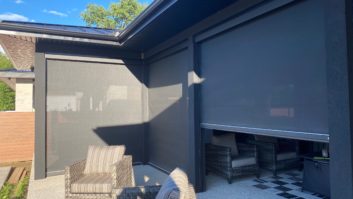When youre down and out, theres nowhere to go but up. If youre at your peak, however, the next step may require you to branch out.
Such is the case for many custom installation companies that have mastered their core competency. For many, this involves the design and integration of audio, video, and home entertainment systems. Once they reach their sales plateau, its time to start investigating other potential profit centers.
This doesnt just mean adding new product lines, which is a natural evolution in any business. To grow, many companies need to diversify, which is similar to starting an entirely new business. To do this and make money, business owners must plan carefully.
Larry Dashiell, president and CEO of HomeTech Systems, a custom installation firm based in Santa Rosa, California, has direct experience with diversification. In 1990, he launched HomeTech after operating his familys electrical contracting business, which still exists today. The most important factor in establishing a new venture, Dashiell preaches, is a sound business plan.
You need to understand the market before you jump into it. Do some research and spend a little time to understand what you are doing so that you can make an educated decision, he said. Its still an educated guess like an estimate is, but at least you are educated about it and you understand what you are getting into.
Eric Bodley of consulting firm Bodley and Associates instructs companies to ensure that they are running efficiently before starting anything new. Before launching a diversification initiative, Bodley says, youve got to have your day-to-day operational issues solved. It becomes easier to layer on new income sources if your accounting is in place, your warehousing is structured, and you have the ability to create proposals that accurately reflect what the customer is buying and what it will take in terms of time, resources, and product to fulfill the order. If you are shooting from the hip, its going to make it very difficult to track your real costs and opportunities. You may see revenue coming in, but it may be costing you more money to be in that business than what you are actually receiving in true net income.
While some companies may be given the opportunity to diversify through a client request, this isnt always an effective approach. In many cases, companies will try this on one joba very large joband they havent done lighting control or some other aspect of low voltage, and they decide to try it out on this job without understanding all of the implications, Bodley observed. If problems arise, this can result in lost revenue and an unhappy client.
One of the main challenges that custom installation companies face is that their markets can be limited; there are only so many homeowners that are capable of purchasing high-end systems, Bodley notes. As a CEDIA past president, guest lecturer, and consultant, he advises companies to assess their current clientele. In order to grow revenues and grow the company, the key isnt finding more customers; the key is selling more to the same customers, he said. You are already there installing audio, video, and home theater, yet there are other electronics needs like lighting, security, communications, and so on.
At any rate, the homeowner probably has plans to purchase these products, Bodley points out. If you dont offer them as an installation company, there is going to be another company on the job site, working on that aspect of the system, and, in many cases, they also offer audio, video, and home theater, he said. If you dont provide it, then thats money left on the table, and it leaves the door open for a competitor to come in and offer a full-service approach rather than just a specialty.
Those companies that diversify their offerings must be aware that it doesnt end at the sale; eventually, clients will require their systems to be serviced. Once you have started a new business, two, three or four years later, servicing those systems that you have sold becomes mandatory if you want to continue to receive referrals from previous customers, Bodley noted.
At HomeTech, Dashiell and his management team endeavor to leverage as many efficiencies as possible. Our accounting department is consolidated, and our purchasing and warehousing is becoming more consolidated, Dashiell explained. Probably the biggest thing I took from the electrical business were efficiencies. Labor and field efficiencies are a big issue in our business, and there is a fine line between being efficient and offering good customer service. This industry is really focused on the customer side of it, and not so much focused on the efficiency side. If you do a lot of fixed pricing, you need to be able to manage your job in order to get paid for the number of hours that it takes to do a project.
While it makes sense for diversified companies to utilize their back office infrastructuresuch as accounting and purchasingfor all ventures, Bodley points to the advantages of drawing a clear line between divisions. Instead of just immediately using your resources and the same people to start into a new area, sometimes completely building a separate model around it works better, Bodley said. If you separate it and make it stand on its own two legs and then find out where economies of scale, its probably a safer and more profitable way to go about it.
Before making the leap, however, its necessary to evaluate your existing company from top to bottom. Job One for most companies is to really, truly analyze how they make money. Its not how much you sell; its how much you keep, Bodley added. Just the fact that you are churning money through the company doesnt mean that you are making money.
And, launching into another business may not be the best way to turn a profit, cautions Warrenton, Virginia-based management consultant and accountant Darrell McComber. The problem with going in a bunch of directions is that you need talent that is either subcontracted by youand not as profitableor it is a new fixed cost on your payroll that you must create a new profit center for, such as security, lighting, and central vac, he said. I am not against diversifying your business into all of the different areas that are out there, but I think you have to add them in context with continuing to grow the areas that make you the most money, and try to get into these areas as efficiently as possible.
Diversification might not be for every company, but as technologies continue to converge, there is a need for custom installers that boast a large service roster. I dont know if its going to be necessary to offer everything, but I think its going to be more and more important for a company to be able to handle a lot of different facets of the low voltage aspects of our projects, Dashiell noted. Everything started to come together with IT incorporated into the systems, so you better be able to handle the IT part. Also, the more the industry matures the more that the prices are going to come down on product. People need to be more focused on services than products.
Carolyn Heinze ([email protected]) is a freelance writer/editor.







